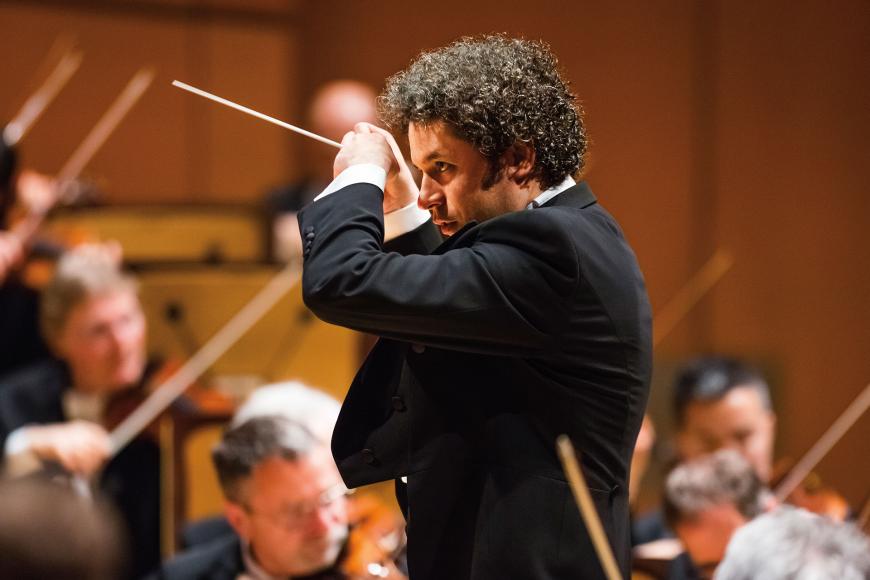
The good news is that Thomas Adès’s brilliant, evening-length ballet Dante finally got its U.S. premiere in Los Angeles over the past weekend. But it arrived only after an unexpectedly long, tortuous trip.
To recap the saga, we had already heard its tumultuously-received first part, “Inferno,” twice in 2019 — first at the world premiere in Walt Disney Concert Hall in May with Gustavo Dudamel and the Los Angeles Philharmonic, and then in July with the Royal Ballet onstage and the composer leading the LA Phil in the Dorothy Chandler Pavilion pit. What was originally thought to be a 25-minute “open-ended” commission for the LA Phil had expanded into a 45-minute Part One of a much bigger piece, with two more sections yet to be written. The whole ballet was set to receive its U.S. premiere under Dudamel’s baton in April 2021, following the world premiere of the staged version by the Royal Ballet in London in May 2020.
Enter COVID-19. The performing-arts world shut its doors two months short of the scheduled London performance, which was postponed and ultimately took place last October. The U.S. premiere was moved back by a year and three weeks, now positioned as the centerpiece of the LA Phil’s Gen X festival, with Adès, born 1971, conveniently placed within that generation. It would occupy an entire program as would a Mahler symphony or Tchaikovsky ballet — a rarity for a brand-new orchestral work in this day and age.
Now that we can finally hear Dante as a whole (I caught the Friday morning, Apr. 29, performance), let’s come right out and say it. This is Adès’s masterpiece, the blossoming of his initial promise as an emerging giant of British music. Not only that, it is an accessible masterpiece with real, visceral appeal for a general classical audience, not just new music devotees.

Based on Dante’s The Divine Comedy, Dante opens with “Inferno,” which occupies nearly one half of the 91-minute ballet. Adès’s musical inspiration for “Inferno” was Franz Liszt, who dealt with the kingdom of the underworld repeatedly in his tone poems and piano works. With Liszt apparently in mind, there is a showmanlike flair to the walloping opening that signals the descent into Dante’s Hell and the succession of irresistible dance episodes as we encounter the motley cast of Dantesque residents and scenes of eternal damnation.
A skilled manipulator of the classical past, Adès didn’t reveal just how much he drew from Liszt until the current set of program notes; he says, “‘Inferno’ moves from 100 percent Liszt orchestrated by me to 100 percent me, and it moves very freely between them.” It turns out that the most infectiously popular part of the score, “The Thieves,” is actually based on a literal orchestral transcription of Liszt’s piano piece Grand Galop Chromatique (a comparison of the Liszt and Adès printed scores confirms this), thus turning its title into a Freudian slip. Again, as in the 2019 performances, “The Thieves” provoked a spontaneous ovation from the audience in mid-piece. Applause seems to have become a built-in feature at that spot.
The two “new” sections, “Purgatorio” and “Paradiso,” which last about 22 minutes and 26 minutes respectively, comprise the second half — and when heard with “Inferno.” they conjure two very different sound worlds that aren’t nearly as flashy and spectacular. Yet they give the entire work the unity, symmetry, and finish of a completed sentence.
Following the intermission break after the gloom of the closing episode of “Inferno,” “Purgatorio” opens with the ghostly, windy sounds of wind and brass players blowing through their instruments without mouthpieces or reeds. The strings freely pass their bows across the bridges of their instruments, creating pitchless “white noise.” A recorded voice loudly cantillates a chant based on material emanating from, as it happens, the Ades Synagogue in Jerusalem. Suddenly we’re in the Middle East, the voices multiply and surround the audience, the piano and harp add luminosity, and the dance grows more furious until the grand “Ascent” closes it off.
“Paradiso” begins amorphously, with lots of canons and arpeggios that seem stuck in place at first. But gradually, we get the sense that things are slowly ascending continuously as the texture gets lighter and brighter. Toward the close, the wordless voices of members of the Los Angeles Master Chorale, invisible to me in Orchestral Level 3, seem to be coming from the rear of the hall, building to a cluster chord centered in the key of C as the orchestra swells to a loud, radiant conclusion.
The orchestra knows “Inferno” well by now, playing with relish and whimsy, and Dudamel, as ever attuned to its grooves, gave it an extra zip that cut two minutes off its timing to about 43 minutes. The performance was being recorded “for future release” — most likely, I would think, on Dudamel’s label Deutsche Grammophon if it happens. With that as a guide, if there are other orchestras willing, daring, and technically able to take it up, Dante or its parts should become very popular.








